A cemetery is land set aside for burial or entombment. Geography, religion, and social attitudes all affect where and how a community buries its dead.
Cemeteries have drawn scholarly attention, but findings are often contradictory. A few enduring themes do emerge from the literature. For example, there is an association between church attendance and cemetery visits.
Historical Connection
Cemeteries are a part of the history of a community, and provide an important window into how the residents of a place once lived. Headstones and other mementos offer insights into jobs, relationships, social connections, and other aspects of a person’s life. Researchers have found evidence of respectful burial in tombs from the Stone Age that were discovered with a variety of tools, vessels and utensils still intact.
The terms ‘graveyard’ and ‘cemetery’ are often used interchangeably, but there is a difference in meaning. A graveyard is land that has been set aside for burial, usually attached to a church. The word comes from the Greek koimeterion, meaning sleep or resting place.
Unlike other city property, cemetery land does not generally come under the power of condemnation. Speculative cemetery crazes have swept the country from time to time, and it is best for cities to take a proactive role in keeping an eye on these developments.
Peaceful Environment
A cemetery provides a peaceful environment where people can grieve in peace. This allows individuals to focus on pursuing their goals and aspirations without the distraction of fear and conflict.
Peaceful environments are essential for businesses, schools, and hospitals to operate effectively. They promote teamwork and collaboration between employees, allowing for the exchange of ideas and the creation of new solutions to problems. In addition, they allow students to learn in an atmosphere free of anxiety and fear, promoting a more positive learning experience.
A cemetery also gives people the opportunity to visit loved ones’ graves and pay their respects. Despite the fact that visiting is not mandatory, many families choose to do so, leaving behind flowers and other decorations on the gravestones. However, these decorations can often become unmaintained due to the passage of time and environmental conditions. This can lead to damage or even destruction of the grave monuments and headstones. This can result in a grave being re-used, which can cause distress to family members.
A Place of Remembrance
For many people, a cemetery is a special place to remember and honor the deceased. Many people choose to decorate a grave with flowers or other tributes to show love and respect for their loved ones. Others may bring cleaning supplies to gently clean a headstone, which is a way of showing they care for the memory of their loved one.
Burial rituals around the world have changed over time. As populations grew, church graveyards became full, and independent sites called cemeteries began to be established. The word cemetery comes from the Greek koimeterion, meaning “sleeping place” or “dormitory.”
Visiting a cemetery is often a very emotional experience. When visiting a gravesite, it is important to maintain a hushed tone and respect the feelings of those around you. It is also a good idea to familiarize yourself with the rules of each cemetery before you visit, as they may have different guidelines for visitors than you are used to.
A Place of Healing
Whether a loved one chooses burial or cremation, the location of their final resting place is an important decision. Cemeteries offer many options that can fit any individual’s needs. There are also a variety of funeral services that can be held at the cemetery, which can provide comfort throughout the grieving process.
The setting of a cemetery, with its quiet, peaceful environment and shady trees, can be comforting when dealing with the loss of a loved one. In addition, there are traditions such as visiting on special dates like anniversaries or birthdays that can help with the healing process.
In keeping with Gibson’s notion of affordance, it is possible that memorial landscapes facilitate and guide, but also constrain and forbid, certain actions and behaviors. Thus, they may serve as a site for the societal transformation that comes with overcoming grief and recognizing life’s fragility and preciousness.







